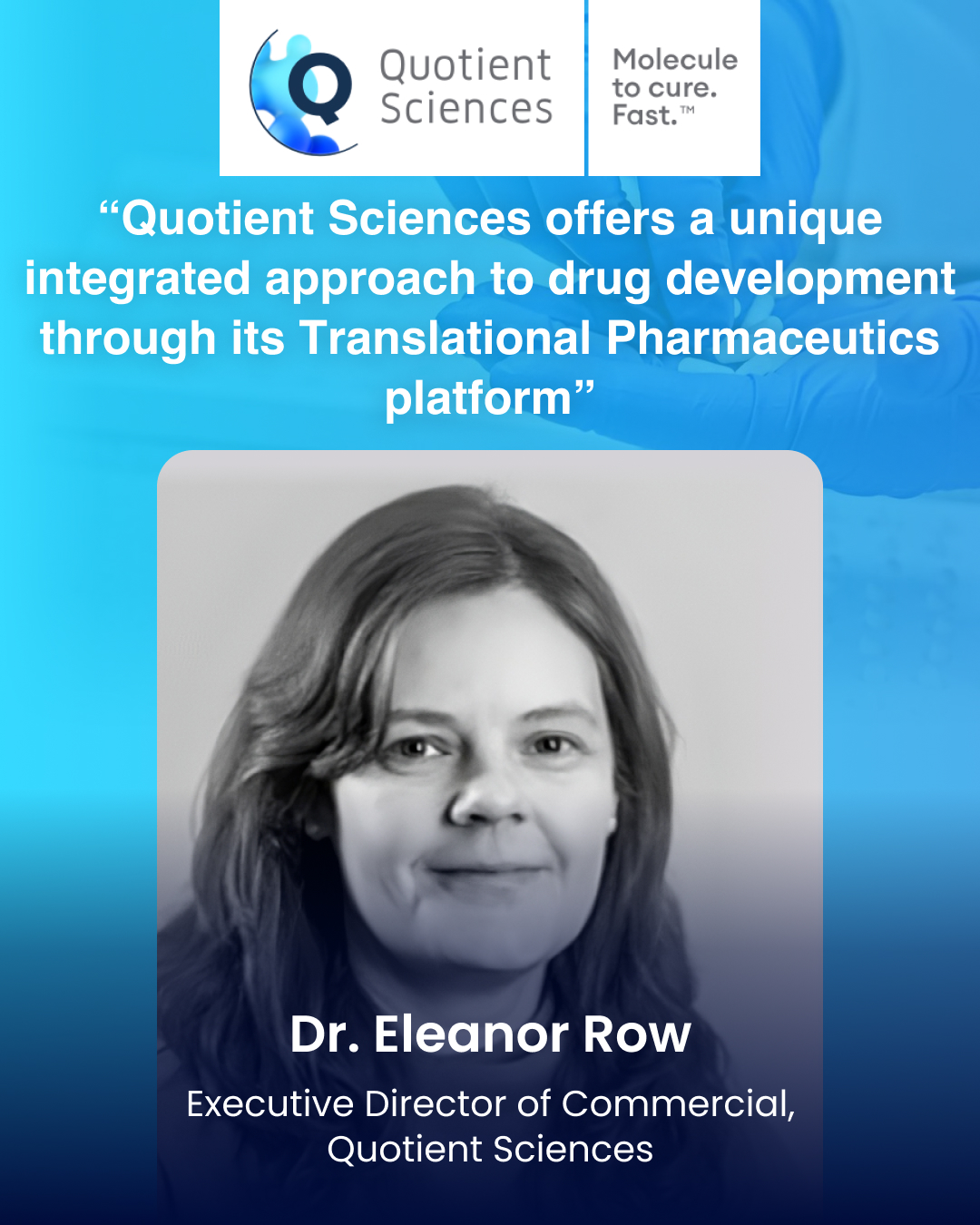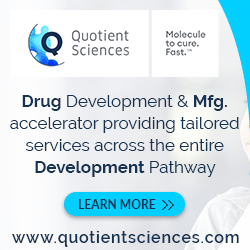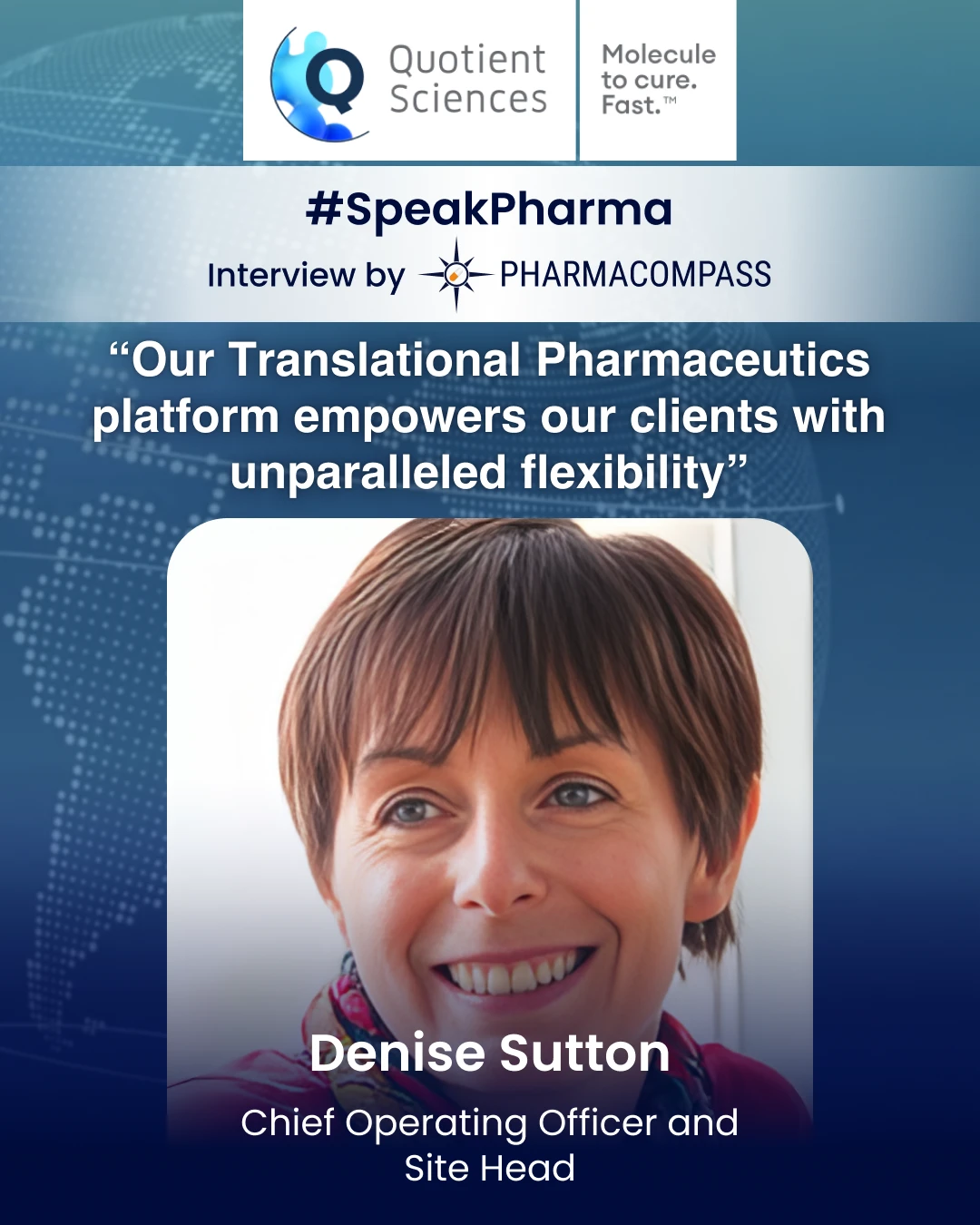
#SpeakPharma with Quotient Sciences
2023-05-15
Impressions: 2288
This week, SpeakPharma interviews Eleanor Row, Executive Director of Commercial at Quotient Sciences, a global drug development accelerator with state-of-the-art development, manufacturing and clinical testing facilities in the US and UK. Over the last 30 years, Quotient has worked on over 3,000 molecules across all stages of development. Row discusses the challenges and considerations that drug developers should be aware of when trying to quickly get their molecule from discovery to investigational new drug (IND) stage and onward into the clinic. While throwing light on the different development functions at an early stage of drug development, she also talks about how an integrated approach can help accelerate a molecule’s pathway to IND and beyond.
What are the main challenges that drug developers face today in getting their molecules IND-ready?
When transitioning from discovery to IND, there are many challenges that drug developers can face. The first challenge in any drug development program is to select the best molecule from various potential leads. During this stage, lead candidates are evaluated based on their early biopharmaceutical ‘developability’, in vitro activity, and their ability to demonstrate acceptable specificity and selectivity for the biological target of the desired therapeutic area.
Once a solid lead candidate is selected, the next goal is to complete all necessary drug product development and safety studies that will support regulatory approval to begin a first-in-human (FIH) phase 1 clinical trial.
In addition to exhibiting an acceptable pharmacokinetic (PK) profile and demonstrating in vivo efficacy, it is crucial to show that the drug has a good safety pharmacology margin with an acceptable drug-drug interaction (DDI) profile. Access to increasing quantities of drug substance becomes even more critical at this stage, and the focus shifts from synthesizing small quantities of material from medicinal chemistry routes to developing a scalable synthetic process (PR&D) and providing the first kilogram of Good Manufacturing Practice (GMP)-grade material suitable for early clinical development.
What should drug substance decision-makers be considering at this stage?
While developing a drug substance manufacturing process, it is crucial to optimize the synthetic route early on. Any changes to the route at a later stage can be time consuming, costly and may require additional bridging toxicology studies due to differences in the impurity profile.
Designing a synthetic process that is robust and commercially scalable helps avoid common pitfalls that can add risk to material supply. During this stage, it is important to minimize the number of steps (either by telescoping or identifying commercially available starting materials with a robust supply chain), develop simple strategies for purification and isolation, and eliminate the use of any hazardous reagents or intermediates, particularly genotoxic impurities (GTIs).
During the process of developing a drug substance, it is important to take into account the impurities that are produced along with the substance. Impurities can be easily identified and quantified by performing analytical method development alongside synthesis. This provides a good understanding of the fate of impurities and control points within the drug substance synthesis at an early stage and helps reduce development timelines. Non-GMP demonstration batches can be manufactured as soon as the synthetic methodology is available. Once material is available, stability studies can be initiated to support the clinical shelf life and pivotal data for the CMC dossier submission.
It is also crucial to have a long-term regulatory strategy and to identify potential GMP starting materials appropriate to the development stage. Regulatory starting materials (RSMs) should be chosen to allow enough stages to be performed under GMP to demonstrate control over the drug substance’s quality. Changing the API at a later stage in clinical development to meet the increased regulatory requirements may cause additional costs, risks and delays, as additional clinical studies may be needed to prove that changes in the starting materials do not change the toxicology or impurity profiles of the final material.
Finally, the selection of the right physical form is often overlooked during early development. Making the right decisions early on can lead to a more robust drug substance isolation strategy and formulation to take into the clinic, resulting in reduced drug product development timelines. Defining the desired salt form or free form of the molecule earlier in the project also brings with it the advantage of doing away with the need of bridging toxicology or stability studies further downstream. It can also lead to a much stronger intellectual property (IP) position.
What considerations should formulation and clinical manufacturing teams be aware of at this stage of dosage form development?
Understanding the physical form and behavior of a molecule is crucial for designing a suitable formulation for the clinic. Technology selection is determined by the solubility and permeability of a molecule, utilizing the Developability Classification System (DCS) or the Bioavailability Classification System (BCS). Providing the data sooner to the formulators can significantly reduce the lead time to a clinic-ready formulation. The use of a simple, fit-for-purpose formulation during an early clinical evaluation program is a tried and tested solution that offers significant time and cost benefits compared to alternative strategies. This approach also provides flexibility for dosing administration during early clinical studies since dosing regimens are not fully defined at this stage.
Why is it beneficial for chemistry, CMC and clinical groups to be engaged with one another in early development?
Typically, drug substance, drug product, and clinical testing activities are conducted by different organizations. This is a classic approach, but it is time consuming and costly, leading to poor knowledge and material transfer between organizations and increasing the risk of program delays.
At Quotient Sciences, we offer a unique approach to drug development through our proprietary Translational Pharmaceutics platform. We have the unique ability to integrate drug substance, drug product, and clinical testing activities under a single organization and program manager. This enables process development, analytical, and formulation chemists to interact and work together from the beginning till the end of the project, ensuring data and drug substance information is shared between teams. As a result, activities that would typically begin after the completion of the drug substance program can begin several months earlier.
Using this integrated approach, we can reduce drug development timelines in the candidate development stage by an average of three to six months, which translates into significant R&D cost savings. Our collective experience of over 15 years and 500 Translational Pharmaceutics programs ensures a smooth review by regulators, accelerating clinical trial approval. Our integrated approach significantly reduces drug development timelines from candidate selection to clinical development, reducing the overall program risk and enhancing the likelihood of downstream clinical and commercial success.
What should clinical operations teams be aware of during early-stage development?
As a molecule approaches IND transition, there are several unknowns that can affect its future success in downstream development and clinical trials. Success in the clinic is often linked to the early establishment of efficacy and the current trend of including patient investigations in the first clinical protocol. However, this approach has several factors that can impact the program’s timeline, such as patient population size for recruitment and resource constraints. Implementing such a study design can often result in a significant delay in the first dose in human milestone, which is critical to confirming real drug exposures that will ultimately drive the efficacy question.
Leveraging a healthy volunteer study can help clinical operations teams focus their attention on answering immediate questions about their molecule’s development. This approach allows clinical teams to keep an eye on future pivotal efficacy investigations without delaying the collection of decision-making data.
How can an integrated program help accelerate the pathway to IND?
When drug developers move from drug discovery to pre-clinical and clinical development, one of the challenges they face is splitting their program across multiple service providers. This places the burden of project management on them and creates gaps in the development timeline, leading to limited knowledge and material sharing as well as adding time and cost to the program. Quotient Sciences’ Translational Pharmaceutics platform lets customers benefit from holistic scientific advice. Our projects are data-driven and scientific, and are led by multi-disciplinary project teams with expertise in CMC, clinical and biopharmaceutics.
Through tight integration of early development activities under a single organization, Quotient Sciences breaks down traditional industry silos, accelerating timelines and reducing risks. Customers not only benefit from the time and cost savings that Quotient Sciences and our Translational Pharmaceutics platform provide for their programs, but they also meet the end-goal of getting new medicines to patients faster.





